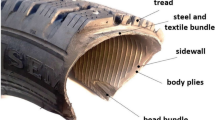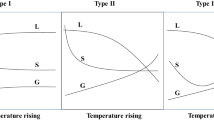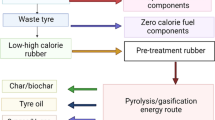Abstract
The health and environmental consciousness of waste tires has increased tremendously over the years. This has motivated efforts to develop secondary applications that will utilize tire when they reach the end of their life cycle and limit their disposal in landfills. Among the applications of waste tires which are discussed in this review, the use of rubber crumbs in artificial turf fields has gained worldwide attention and is increasing annually. However, there are serious concerns regarding chemicals that are used in the manufacturing process of tires, which ultimately end up in rubber crumbs. Chemicals such as polycyclic aromatic hydrocarbons (PAH) and heavy metals which are found in rubber crumbs have been identified as harmful to human health and the environment. This review paper is intended to highlight some of the methods which have been used to manage waste tire; it also looks at chemicals/materials used in tire compounding which are identified as possible carcinogenic.




Similar content being viewed by others
References
Abhitha K, Thomas K (2013) Safe vulcanization system for heat resistant natural rubber products for engineering applications. American Journal of Engineering Research 3:13
Adeniji, A. O., O. O. Okoh and A. I. Okoh (2017). Analytical methods for polycyclic aromatic hydrocarbons and their global trend of distribution in water and sediment: a review. Recent Insights in Petroleum Science and Engineering, IntechOpen
Ahlbom, J. and U. Duus (2003). "HA Oils in automotive tyres prospects of a national ban." KEMI Report(5/03)
Ahmadi F, Rezaei H, Tahvilian R (2012) Computational-aided design of molecularly imprinted polymer for selective extraction of methadone from plasma and saliva and determination by gas chromatography. J Chromatogr A 1270:9–19
Annexure, H. (2005). "National waste management strategy implementation South Africa."
Antoniou N, Zabaniotou A (2013) Features of an efficient and environmentally attractive used tires pyrolysis with energy and material recovery. Renew Sust Energ Rev 20:539–558
Aprem AS, Thomas S, Joseph K, Barkoula NM, Kocsis JK (2003) Sulphur vulcanisation of styrene butadiene rubber using new binary accelerator systems. Journal of Elastomers & Plastics 35(1):29–55
Asif M, Muneer T (2007) Energy supply, its demand and security issues for developed and emerging economies. Renew Sust Energ Rev 11(7):1388–1413
Atal A, Levendis YA (1995) Comparison of the combustion behaviour of pulverized waste tyres and coal. Fuel 74(11):1570–1581
Bandzierz K, Reuvekamp L, Dryzek J, Dierkes W, Blume A, Bielinski D (2016) Influence of network structure on glass transition temperature of elastomers. Materials 9(7):607
Birkholz DA, Belton KL, Guidotti TL (2003) Toxicological evaluation for the hazard assessment of tire crumb for use in public playgrounds. J Air Waste Manage Assoc 53(7):903–907
Blomberg J, Schoenmakers PJ, Beens J, Tijssen R (1997) Compehensive two-dimensional gas chromatography (GC× GC) and its applicability to the characterization of complex (petrochemical) mixtures. J High Resolut Chromatogr 20(10):539–544
Blomqvist P, McNamee MS, Andersson P, Lönnermark A (2012) Polycyclic aromatic hydrocarbons (PAHs) quantified in large-scale fire experiments. Fire Technol 48(2):513–528
Blomqvist P, Persson B, Simonson M (2007) Fire emissions of organics into the atmosphere. Fire Technol 43(3):213–231
Brazkova, M. and A. Krastanov (2013). "Polycyclic aromatic hydrocarbons: sources, effects and biodegradation." НАУЧНИ ТРУДОВЕ
Brown, D. (2006). True recycling of rubber–myth or reality? rubber mini expo 06: 170 th technical meeting of the american chemical society, Rubber Division 2006
Bukowiecki N, Lienemann P, Hill M, Furger M, Richard A, Amato F, Prévôt A, Baltensperger U, Buchmann B, Gehrig R (2010) PM10 emission factors for non-exhaust particles generated by road traffic in an urban street canyon and along a freeway in Switzerland. Atmos Environ 44(19):2330–2340
Caponero J, Tenório JA, Levendis YA, Carlson JB (2005) Emissions of batch combustion of waste tire chips: the pyrolysis effect. Combust Sci Technol 177(2):347–381
Cheng H, Hu Y, Reinhard M (2014) Environmental and health impacts of artificial turf: a review. Environmental science & technology 48(4):2114–2129
Chou L (1997) Artificial reefs of Southeast Asia-do they enhance or degrade the marine environment? Environ Monit Assess 44(1–3):45–52
Ciesielski, A. (1999). An introduction to rubber technology, iSmithers Rapra publishing
Courtemanche B, Levendis YA (1998) A laboratory study on the NO, NO2, SO2, CO and CO2 emissions from the combustion of pulverized coal, municipal waste plastics and tires. Fuel 77(3):183–196
Crain, W. and J. Zhang (2006). "Hazardous chemicals in synthetic turf." Rachel's Democracy and Health News 873
Dasgupta S, Agrawal S, Bandyopadhyay S, Chakraborty S, Mukhopadhyay R, Malkani R, Ameta S (2007) Characterization of eco-friendly processing aids for rubber compound. Polym Test 26(4):489–500
de Oliveira Neto GC, Chaves LEC, Pinto LFR, Santana JCC, Amorim MPC, Rodrigues MJF (2009) Economic, Environmental and social benefits of adoption of pyrolysis process of tires: a feasible and ecofriendly mode to reduce the impacts of scrap tires in Brazil. Sustainability 11:2076l
De, S. K. and J. R. White (2001). Rubber technologist's handbook, iSmithers Rapra Publishing
Denly, E., K. Rutkowski and K. M. Vetrano (2008). A review of the potential health and safety risks from synthetic turf fields containing crumb rubber infill, TRC--Environmental Consultants
Depaolini AR, Bianchi G, Fornai D, Cardelli A, Badalassi M, Cardelli C, Davoli E (2017) Physical and chemical characterization of representative samples of recycled rubber from end-of-life tires. Chemosphere 184:1320–1326
Doak S, Brown V, Hunt P, Smith J, Roe F (1983) The carcinogenic potential of twelve refined mineral oils following long-term topical application. Br J Cancer 48(3):429–436
Drabova L, Pulkrabova J, Kalachova K, Tomaniova M, Kocourek V, Hajslova J (2012) Rapid determination of polycyclic aromatic hydrocarbons (PAHs) in tea using two-dimensional gas chromatography coupled with time of flight mass spectrometry. Talanta 100:207–216
Evans, A. and R. Evans (2006). "The composition of a tyre: typical components." The Waste & Resources Action Programme 5
Evans, M. S. (2002). Tyre compounding for improved performance, iSmithers Rapra publishing
Ezzoddin S, Abbasian A, Aman-Alikhani M, Ganjali ST (2013) The influence of non-carcinogenic petroleum-based process oils on tire compounds’ performance. Iran Polym J 22(9):697–707
Fauser P, Tjell JC, Mosbaek H, Pilegaard K (2002) Tire-tread and bitumen particle concentrations in aerosol and soil samples. Pet Sci Technol 20(1–2):127–141
Forrest, M. (2014). Recycling and re-use of waste rubber, Smithers Rapra
Fragassa C, Ippoliti M (2016) Technology assessment of tire mould cleaning systems and quality finishing. International Journal for Quality Research 10(3)
Frigo S, Seggiani M, Puccini M, Vitolo S (2016) Liquid fuel production from waste tyre pyrolysis and its utilisation in a diesel engine. Fuel. 116:399–408
Geiss O, Senaldi C, Bianchi I, Lucena A, Tirendi S, Barrero-Moreno J (2018) A fast and selective method for the determination of 8 carcinogenic polycyclic aromatic hydrocarbons in rubber and plastic materials. J Chromatogr A 1566:13–22
Godlewska J (2017) Recovery and recycling of waste tires in Poland. Procedia Eng 182:229–234
Gonzalez, J.F., Encinar, J.M., Canito, J.L. and Rodriguez, J.J. (2001).” Pyrolysis of auto mobile tyre waste. Influence of operating variables and kinetics study”. Journal of Analytical and Applied Pyrolysis 58:667–683
Gray TM, Simpson BJ, Nicolich MJ, Murray FJ, Verstuyft AW, Roth RN, McKee RH (2013) Assessing the mammalian toxicity of high-boiling petroleum substances under the rubric of the HPV program. Regul Toxicol Pharmacol 67(2):S4–S9
Gruber, L., Schlummer, M., Fiedler, D., Barwitz, M., Smilic, S., Franz, R. (2017). Untersuchungen zur Migration von Polyzyklischen Aromatischen Kohlenwasserstoffen (PAK) aus altreifenhaltigen Gummiprodukten. Report PA/4453/17, in, Fraunhofer-Institut fuer Verfahrenstechnik und Verpackung, Freising/Germany
Hamm S, Frey T, Weinand R, Moninot G, Petiniot N (2009) Investigations on the extraction and migration behavior of polycyclic aromatic hydrocarbons (PAHs) from cured rubber formulations containing carbon black as reinforcing agent. Rubber Chem Technol 82(2):214–228
Han I-K, Zhang L, Crain W (2008) Hazardous chemicals in synthetic turf materials and their bioaccessibility in digestive fluids. Journal of Exposure Science and Environmental Epidemiology 18(6):600
Harrison RM, Yin J, Mark D, Stedman J, Appleby RS, Booker J, Moorcroft S (2001) Studies of the coarse particle (2.5–10 μm) component in UK urban atmospheres. Atmos Environ 35(21):3667–3679
Islama MR, Islama MN, Mustafia NN, Rahima MA, Haniub H (2013) Thermal recycling of solid tire wastes for alternative liquid fuel: the first commercial step in Bangladesh. Procedia Engineering 56:573–582
Jang JW, Yoo T-S, Oh J-H, Iwasaki I (1988) Discarded tire recycling practices in the United State, Japan and Korea. Resour Conserv Recycl 22(1–2):1–14
Jansen, S., A. Schmeitz, S. Maas, C. Rodarius and L. Akkermans (2014). Study on some safety-related aspects of tyre use, TNO
Juma M, Korenova Z, Markos J, Annus J, Jelemensky L (2006) Pyrolysis and combustion of scrap tire-review. Petroleum & Coal 48(1):15–26
Kandah M, Al-Otoom A, Al-Harahsheh M, Al-Zoubi RM, Al-Harahsheh A (2017) Extracting oil from used auto tires at low temperature after chemical treatment. Waste Manag 61:307–314
Kanematsu M, Hayashi A, Denison MS, Young TM (2009) Characterization and potential environmental risks of leachate from shredded rubber mulches. Chemosphere 76(7):952–958
Kruželák J, Sýkora R, Hudec I (2016) Sulphur and peroxide vulcanisation of rubber compounds–overview. Chem Pap 70(12):1533–1555
Lagarinhos CAF, Tenorio JAS (2013) ReverseLogistics for post-consumer tires in Brazil. Polimeros 23:49–58
Lee, K., N. M. Yusoff, N. Othman and N. M. Aini (2017). Effect of vulcanization temperature on curing characteristic, physical and mechanical properties of natural rubber/palygorskite composites. IOP Conference Series: Materials Science and Engineering, IOP Publishing
Lee, M. (2012). Analytical chemistry of polycyclic aromatic compounds, Elsevier
Li X, Berger W, Musante C, Mattina MI (2010a) Characterization of substances released from crumb rubber material used on artificial turf fields. Chemosphere 80(3):279–285
Li X, Xu H, Gao Y, Tao Y (2010b) Comparison of end-of-life tire treatment technologies: a Chinese case study. Waste Manag 30(11):2235–2246
Lim, L. and R. Walker (2009). An assessment of chemical leaching: releases to air and temperature at crumb-rubber Infilled synthetic turf fields, New York State Department of Environmental Conservation
Llompart M, Sanchez-Prado L, Lamas JP, Garcia-Jares C, Roca E, Dagnac T (2013) Hazardous organic chemicals in rubber recycled tire playgrounds and pavers. Chemosphere 90(2):423–431
Longvinenko, A. (2018). Use of rubber crumbs in cement concrete. IOP Conference Series: Materials Science and Engineering, IOP Publishing
Lönnermark, A. And P. Blomqvist (2005). Emissions from tire fires
Lopez-Avila V, Young R, Benedicto J, Ho P, Kim R, Beckert WF (1995) Extraction of organic pollutants from solid samples using microwave energy. Anal Chem 67(13):2096–2102
Machin EB, Pedroso DT, de Carvalho Jr JA (2017) Energetic valorization of waste tires. Renew Sust Energ Rev 68:306–315
Marsili L, Coppola D, Bianchi N, Maltese S, Bianchi M, Fossi MC (2015) Release of polycyclic aromatic hydrocarbons and heavy metals from rubber crumb in synthetic turf fields: preliminary hazard assessment for athletes. Journal of Environmental & Analytical Toxicology 5(2):1
Menichini E, Abate V, Attias L, De Luca S, Di Domenico A, Fochi I, Forte G, Iacovella N, Iamiceli AL, Izzo P (2011) Artificial-turf playing fields: contents of metals, PAHs, PCBs, PCDDs and PCDFs, inhalation exposure to PAHs and related preliminary risk assessment. Sci Total Environ 409(23):4950–4957
Mirmiran S, Pakdel H, Roy C (1992) Characterization of used tire vacuum pyrolysis oil: nitrogenous compounds from the naphtha fraction. J Anal Appl Pyrolysis 22(3):205–215
Moretto, R. (2007). "Environmental and health assessment of the use of elastomer granulates (virgin and from used tyres) as filling in third-generation artificial turf." EEDEMS (Ademe, Aliapur, Fieldturf Tarkett
Mui ELK, Cheung WH, McKay G (2010) Tyre char preparation from waste tyre rubber for dye removal from effluents. J Hazard Mater 175:151–158
Nash HA (2009) The revised directive on waste: resolving legislative tensions in waste management? Journal of Environmental Law 21(1):139–149
Naviglio D, Scarano P, Ciaravolo M, Gallo M (2019) Rapid solid-liquid dynamic extraction (RSLDE): a powerful and greener alternative to the latest solid-liquid extraction techniques. Foods 8(7):245
Nazzal J (2007) The presence of polycyclic aromatic hydrocarbons (PAH) in oil obtained t pyrolysis of Jordan oil shale. Oil shale 24(3):465
Ngxangxa S (2016) Development of GC-MS methods for the analysis of tyre pyrolysis oils. Stellenbosch University, Stellenbosch
Nkosi, N., E. Muzenda, J. Zvimba and J. Pilusa (2013). "The current waste generation and management trends in South Africa: A Review."
Nkosi. N. and Muzenda. E. (2014). A review and discussion of waste tyre pyrolysis and derived products. Proceedings of the world congress on engineering Vol II. ISBN: 978-988-19253-5-0
Null V (1999) Safe process oils for tires with low environmental impact. Kgk Kautsch Gummi Kunstst 52(12):6
Pant P, Harrison RM (2013) Estimation of the contribution of road traffic emissions to particulate matter concentrations from field measurements: a review. Atmos Environ 77:78–97
Petchkaew, A. (2015). Implications of non-carcinogenic pah-free extender oils in natural rubber based tire compounds, Ph.D Thesis . University of Twente, Enschede, the Netherlands. ISBB: 978–90–365-3763-6 Available online at: https://ris.utwente.nl/ws/files/6054459/thesis_A_Petchkaew.pdf
Pilusa, J. and Muzenda E. (2016). Combustion characterristics of waste tyres pyrolysis fuel as industrial burner fuel. In: Developments in Combustion Technology. Edited by K. Kyprianidis and J. Skvaril. Published by IntechOpen.http://dx.doi/.org/105772/63078
Presti DL (2013) Recycled tyre rubber modified bitumens for road asphalt mixtures: a literature review. Constr Build Mater 49:863–881
Qin J, Ding H, Wang X, Xie M, Yu Z (2008) Blending LLDPE and ground rubber tires. Polym-Plast Technol Eng 47(2):199–202
Rathsack P, Riedewald F, Sousa-Gallagher M (2015) Analysis of pyrolysis liquid obtained from whole tyre pyrolysis with molten zinc as the heat transfer media using comprehensive gas chromatography mass spectrometry. J Anal Appl Pyrolysis 116:49–57
Reisman, J. I. and P. M. Lemieux (1997). Air emissions from scrap tire combustion. Air emissions from scrap tire combustion, EPA
Ruffino B, Fiore S, Zanetti MC (2013) Environmental–sanitary risk analysis procedure applied to artificial turf sports fields. Environ Sci Pollut Res 20(7):4980–4992
Sadiktsis, I. (2016). Traffic related air pollution with emphasis on particle associated polycyclic aromatic hydrocarbons: tire wear and biodiesel exhaust emissions, Department of Environmental Science and Analytical Chemistry, Stockholm …
Sadiktsis I, Bergvall C, Johansson C, Westerholm R (2012) Automobile tires* a potential source of highly carcinogenic Dibenzopyrenes to the environment. Environmental science & technology 46(6):3326–3334
Schmidt K, Podmore I (2015) Solid phase microextraction (SPME) method development in analysis of volatile organic compounds (VOCS) as potential biomarkers of cancer. Journal of Molecular Biomarker & Diagnosis 6(6)
Selbes M, Yilmaz O, Khan AA, Karanfil T (2015) Leaching of DOC, DN, and inorganic constituents from scrap tires. Chemosphere 139:617–623
Sharma M (2010) Polycyclic aromatic hydrocarbons, elemental and organic carbon emissions from tire-wear. Sci Total Environ 408(20):4563–4568
Shu X, Huang B (2014) Recycling of waste tire rubber in asphalt and Portland cement concrete: an overview. Constr Build Mater 67:217–224
Shuhaimi NHH, Ishak NS, Othman N, Ismail H, Sasidharan S (2014) Effect of different types of vulcanization systems on the mechanical properties of natural rubber vulcanizates in the presence of oil palm leaves-based antioxidant. Journal of Elastomers & Plastics 46(8):747–764
Sienkiewicz M, Kucinska-Lipka J, Janik H, Balas A (2012) Progress in used tyres management in the European Union: a review. Waste Manag 32(10):1742–1751
Simon, R. (2010). "Review of the impacts of crumb rubber in artificial turf applications."
Singh S, Nimmo W, Gibbs B, Williams P (2009) Waste tyre rubber as a secondary fuel for power plants. Fuel 88(12):2473–2480
Strydom, R. (2017). Enhanced waste tyre pyrolysis for the production of hydrocarbons and petrochemicals, Cape Peninsula University of Technology
Suhanya M, Thirumarimurugan M, Kannadasan T (2013) Recovery of oil from waste tyres using pyrolysis method: a review. International Journal of Research in Engineering & Technology (IJRET) 1(2):81–90
Tielens AG (2008) Interstellar polycyclic aromatic hydrocarbon molecules. Annu Rev Astron Astrophys 46:289–337
Treloar LRG (1975) The physics of rubber elasticity. Oxford University Press, USA
Tshindane P (2018) Application of membrane technology for purifying tyre derived oil. Stellenbosch University, Stellenbosch
Van Rooij JG, Jongeneelen FJ (2010) Hydroxypyrene in urine of football players after playing on artificial sports field with tire crumb infill. Int Arch Occup Environ Health 83(1):105–110
Vetrimurugan E, Brindha K, Elango L, Ndwandwe OM (2017) Human exposure risk to heavy metals through groundwater used for drinking in an intensively irrigated river delta. Appl Water Sci 7(6):3267–3280
Villar-Navarro M, Martín-Valero MJ, Fernández-Torres RM, Callejón-Mochón M, Bello-López MÁ (2017) Easy, fast and environmental friendly method for the simultaneous extraction of the 16 EPA PAHs using magnetic molecular imprinted polymers (mag-MIPs). J Chromatogr B 1044:63–69
Wik A, Dave G (2005) Environmental labeling of car tires—toxicity to Daphnia magna can be used as a screening method. Chemosphere 58(5):645–651
Wik A, Dave G (2006) Acute toxicity of leachates of tire wear material to Daphnia magna—variability and toxic components. Chemosphere 64(10):1777–1784
Wik A, Dave G (2009) Occurrence and effects of tire wear particles in the environment–a critical review and an initial risk assessment. Environ Pollut 157(1):1–11
Williams PT, Taylor DT (1993) Aromatization of tyre pyrolysis oil to yield polycyclic aromatic hydrocarbons. Fuel 72(11):1469–1474
Wulandari PS, Tjandra D (2017) Use of crumb rubber as an additive in asphalt concrete mixture. Procedia engineering 171:1384–1389
Yee DA, Kneitel JM, Juliano SA (2010) Environmental correlates of abundances of mosquito species and stages in discarded vehicle tires. J Med Entomol 47(1):53–62
Funding
Recycling and Economic Development Initiative of South Africa (REDISA) and the National Research Foundation (NRF) of South Africa are acknowledged for providing the bursary funding during the period of compiling the review.
Author information
Authors and Affiliations
Corresponding author
Ethics declarations
Conflict of interest
The authors declare that they have no conflict of interest.
Additional information
Responsible Editor: Philippe Garrigues
Publisher’s note
Springer Nature remains neutral with regard to jurisdictional claims in published maps and institutional affiliations.
Highlights
• Challenges regarding landfilling of waste tires and adopted management strategies
• Information on polycyclic aromatic hydrocarbons from waste tires was reviewed
• Possible leaching or volatilization of PAHs from rubber crumbs from turf fields
• Extraction and purification methods of PAHs from rubber crumbs samples
Rights and permissions
About this article
Cite this article
Sibeko, M.A., Adeniji, A.O., Okoh, O.O. et al. Trends in the management of waste tyres and recent experimental approaches in the analysis of polycyclic aromatic hydrocarbons (PAHs) from rubber crumbs. Environ Sci Pollut Res 27, 43553–43568 (2020). https://doi.org/10.1007/s11356-020-09703-2
Received:
Accepted:
Published:
Issue Date:
DOI: https://doi.org/10.1007/s11356-020-09703-2




